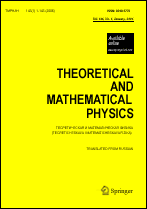|
Boundary conditions and confinement in the gauge field theory at finite temperature
N. A. Sveshnikov, É. G. Timoshenkoa
a University College Dublin
Abstract:
A Hamiltonian formulation of a non-Abelian gauge theory confined in a finite domain is constructed in a generalized three-dimensional Fock–Schwinger gauge in the presence of surface terms. The dependence of the partition function on the boundary value of the longitudinal electric-field component, which because of the Gauss law, coincides with the electric-field flow through an infinitesimal boundary-surface element in this gauge, is investigated. This dependence is related to the confinement–deconfinement phase transition. In the confinement phase, the chromoelectric current through any boundary element is zero, because all observable quantities are singlet w.r.t. the remaining gauge-transformation group, i. e. color objects are unobservable at spatial infinity. In addition to the non-Abelian theory, a simpler example of quantum electrodynamics with an external-charge density in a spherical domain is considered in which the effective partition function is exactly calculable.
Received: 14.04.1998
Citation:
N. A. Sveshnikov, É. G. Timoshenko, “Boundary conditions and confinement in the gauge field theory at finite temperature”, TMF, 117:2 (1998), 206–220; Theoret. and Math. Phys., 117:2 (1998), 1274–1285
Linking options:
https://www.mathnet.ru/eng/tmf927https://doi.org/10.4213/tmf927 https://www.mathnet.ru/eng/tmf/v117/i2/p206
|


| Statistics & downloads: |
| Abstract page: | 312 | | Full-text PDF : | 204 | | References: | 60 | | First page: | 1 |
|




 Contact us:
Contact us: Terms of Use
Terms of Use
 Registration to the website
Registration to the website Logotypes
Logotypes









 Citation in format
Citation in format 